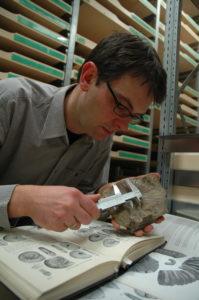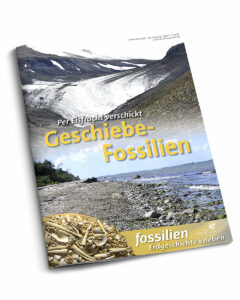Prof. Dr. Jens Lehmann

Contact:
Geosciences Collection
University of Bremen – Faculty 5 (Geosciences)
Building GEO I, Room 5040
Klagenfurter Strasse 4
28359 Bremen
Germany
Tel.: +49-(0)421-218-65016
Fax: +49-(0)421-218-98 65016
jens.lehmann@uni-bremen.de
![]()
Prof. Dr. Jens Lehmann is responsible for the scientific handling of the research collection and for research about a wide choice of specimens and various geological time slices. Thus, a comprehensive networking with scientist from Germany and abroad is a matter of course. The transfer of scientific knowledge into the public is intimately connected, as demonstrated by numerous exhibition projects, including other European countries, and almost 100 public talks for the public. Interested layman might consult Prof. Lehmann to know more about their finds, in case they want to donate specimens to the collection and a far as for assistance for own scientific work. The Geosciences Collection is an active partner in the dialogue between research and society, “Citizen Science” is applied in all individual aspects. This commitment is also the reason for the cooperation with the Quelle & Meyer publishing house and in particular with “Fossilien. Journal für Erdgeschichte” – a journal for which he is an advisory scientist. The research focus of Prof. Lehmann is the reconstruction of the palaeoenvironment, diversity of organisms and ammonoids. These topics are addressed with special focus on the Mesozoic. He is also self dependent in acquiring third-party funds and is coordinating several scientific projects.

New publication by Jens Lehmann in October 2023: Special issue of the journal “FOSSILIEN”
Collecting fossils from erratic boulders derived by the glacial drift is the most family-friendly way to experience Earth history. Especially at the coasts, children can also find loose fossils in a relaxed way and almost everywhere, including the classics “devil’s fingers” and sea urchins in flintstone preservation. In addition, boulder fossils offer a unique chance to find evidence of almost the entire history of life since the Cambrian, as the ice-age glaciers sent us a colourful variety of different fossils from Scandinavia. This special issue covers the entire range of possible discoveries, from “once i a century finds” like the ancient, mysterious stump-footed Xenusion to Germany’s second-oldest bird fossil and the common sea urchin. Particularly beautiful specimens are illustrated; several views of the same piece make this special issue with its generous graphic design an aesthetic pleasure as well. about 80 p., throughout colour ill., 21 x 28 cm. Available since October 2023 at Humanitas.
Recently published journal articles
- Lehmann, J., Küchelmann, H.C., Juhl, F., Mutterlose, J., 2025. Fossil brachiopods from the Roman site on Mogador Island (Essaouira, Morocco): Implications for past exchange of products. – Journal of Island and Coastal Archaeology. DOI: 10.1080/15564894.2025.2485939
- Klug, C., Pohle, A., Bolliger, T., Hagdorn, H., Lehmann, J., 2025. Taphonomic and reworking processes isolating cephalopod septa and chamber fillings. – Lethaia, 1-18. DOI: 10.18261/let.58.2.1
- Cadena, E.-A., Bustos, J., Lehmann, J., 2025. Valanginian and Hauterivian bochianitid ammonoids from the Rosa Blanca Formation of Colombia: Palaeobiogeographic implications. – Cretaceous Research, 106094. DOI: 10.1016/j.cretres.2025.106094.
- Lehmann, J., Aly, M. F., 2024. Cheloniceratinae Spath, 1923 (Ammonoidea, Douvilleiceratidae) in the upper Aptian (Lower Cretaceous) of North Sinai, Egypt. – Annales de Paléontologie, 102688. DOI: 10.1016/j.annpal.2024.102688.
- Lehmann, J., Bayliss, H.M., 2024. Additions to the subfamily Acanthohoplitinae from the British Isles, including the first verifiable record of Acanthohoplites (Lower Cretaceous, upper Aptian). – Cretaceous Research, 105921. DOI: 0.1016/j.cretres.2024.105921.
- Lehmann, J., Bornemann, A., Jattiot, R., Nohra, R., Resch, U., 2024. Age constraint of the Cenomanian (Late Cretaceous) Fossillagerstätte of Hjoûla (Lebanon) based on ammonites. – Newsletters on Stratigraphy 57 (2), 203-223. DOI: 10.1127/nos/2024/0804.
- Szives, O., Moreno-Bedmar, J.A., Aguirre-Urreta, B., Company, M., Frau, C., López-Horgue, M., Pictet, A., Ploch, I., Salazar, C., Barragán, R., Latil, J.-L., Lehmann, J., Robert, E., Reboulet, S., 2024. Report on the 7th International Meeting of the IUGS Lower Cretaceous Ammonite Working Group, the Kilian Group (Warsaw, Poland, 21st August 2022): State of the art on the current Standard Ammonite Zonation of the Western Tethyan Mediterranean Province. – Cretaceous Research 153, 105716. DOI: 10.1016/j.cretres.2023.105716.
- Klug, C., Stevens, K., Hoffmann, R., Zatoń, M., Clements, T., Košťák, M., Weis, R., De Baets, K., Lehmann, J., Vinther, J., Fuchs, D., 2023. Revisiting the identification of Syllipsimopodi bideni and timing of the decabrachian-octobrachian divergence. – Nature Communications 14(1), 8094. DOI: 10.1038/s41467-023-42842-x
- Jattiot, R., Lehmann, J., Kruta, I., Rouget, I., 2023. Mature modifications and sexual dimorphism in Turrilitidae (heteromorph ammonites): Contribution of remarkable Mariella bergeri specimens (upper Albian, southeastern France). – Cretaceous Research 151, 105651. DOI: 10.1016/j.cretres.2023.105651
- Szives, O., Latil, J.-L., Moreno-Bedmar, J. A., Lehmann, J., Robert, E., Owen, H. G., 2023. Critical revision and new proposals on the Aptian–Albian zonation of the standard Mediterranean ammonite zonal scheme. – Newsletters on Stratigraphy 56(4), 423-456. DOI: 10.1127/nos/2023/0753.
- Jattiot, R., Monnet, C., Lehmann, J., Owen, H.G., 2023. Quantitative biochronology by unitary associations of late Albian ammonites from Europe and their biodiversity. – Newsletters on Stratigraphy 56(4), 485-505. DOI: 10.1127/nos/2023/0773
- Lehmann, J., Pickford, M., Desmares, D., 2022. The Wanderfeld IV Cretaceous occurrence near Bogenfels, Namibia: the ammonite Placenticeras and its associated bivalve fauna. – Communications of the Geological Survey of Namibia 25: 32-55.
- Bischof, E. A., Schlüter, N., Lehmann, J., 2022. Geometric morphometric analysis of morphologic disparity, intraspecific variation and ontogenetic allometry of beyrichitine ammonoids. – PLoS ONE 17:(2) e0263524. DOI: 10.1371/journal.pone.0263524
- Jattiot, R., Lehmann, J., Latutrie, B., Tajika, A., Vennin, E., Vuarin, P., Brayard, A., Fara, E., Trincal, V., 2022. Upper upper Albian (Mortoniceras rostratum Zone) cephalopods from Clansayes (Drôme, south-eastern France). – Acta Geologica Polonica. DOI: 10.24425/agp.2021.139308
- Lehmann, J., Bayliss, H. M., 2022. The heteromorph ammonite Tropaeum (Tropaeum) evolutum sp. nov. from the Hythe Formation, Lower Greensand Group (basal upper Aptian, Lower Cretaceous) of Maidstone, Kent, UK. – Cretaceous Research 105110. DOI: 10.1016/j.cretres.2021.105110
Recently published journal articles non review
- Lehmann, J., 2025. Neue Beschilderung für den Usedomer Gesteinsgarten. – Fossilien 42(3), 63.
- Lehmann, J., 2025. Überraschungsfund: Verschollene Großammoniten zurückgekehrt! – Fossilien 42(3), 62.
- Lehmann, J., 2025. Das Museu Balear de Ciènces Naturals auf Mallorca. – Fossilien 42(3), 54-61.
- Lehmann, J., 2025. Konglomerate und fossile Seeigel – unterwegs im Tramuntana-Gebirge von Mallorca. – Fossilien 42(3), 38-43.
- Lehmann, J., 2025. Åsen – eine Fossilfundstelle in der schwedischen Kreide. – Fossilien 42(2), 36-46.
- Lehmann, J., 2024. „Tanz auf dem Vulkan“ – Fossilien aus dem Miozän Madeiras. – Fossilien 41(2), 36-51.
Lehmann, J., 2024. Neueröffnung: die FossilienGrube in Twistringen. – Fossilien 41(4), 36-51.
Lehmann, J., 2024. Die Messe in Sainte-Marie aux-Mines 2024. – Fossilien 41(6), 61.
Lehmann, J., 2024. Der Usedomer Gesteinsgarten – ein Ausflugsziel für Geschiebefreunde. – Fossilien 41(6), 18-25.
Lehmann, J., 2024. Lias-Ammoniten aus dem Geschiebe des Münsterländer KIessandzugs – die Sammlung von Herman Akkerman. – Der Steinkern(56), 12-26. - Lehmann, J., 2024. Ungewöhnliches Echsenfossil aus der Green River Formation – es „fällt wie Schuppen von den Augen“. – Fossilien 41(1), 37-40.
- Lehmann, J., 2023. Meteora – Geologie eines UNESCO-Welterbes. – Fossilien 40(6), 4-15.
- Lehmann, J., 2023. „Turritella-Achat” aus der Green River Formation. – Fossilien 40(5), 58-61.
- Lehmann, J., 2023. Aufschluss Kellwassertal in schlechtem Zustand. GMit. Geowissenschaftliche Mitteilungen 91, 106-107.
- Lehmann, J., Lehmann, L. B., 2023. Torfstiche als anthropogene Wildtierfallen? – Knochenansammlungen des Damhirsches (Dama dama) in Niedersachsen. – Abhandlungen des Naturwissenschaftlichen Vereins zu Bremen 48 (1), 21-26.
- Lehmann, J., 2023. Das Naturkundemuseum in Mailand: Ein Kleinod der Paläontologie. – Fossilien 40(1), 4-11.
- Lehmann, J., 2023. Die Messe in Sainte-Marie-aux-Mines: Immer wieder einen Besuch wert. – Fossilien 40(1), 58-61.
- Lehmann, J., 2022. The art of fossil preparation – a silent revolution in palaeontology. – Naturevolve 12: 17.
- Lehmann, J., 2022. Die Schotter der „Ur-Gera“ von Erfurt – vielfältige Kaltzeitgeologie. – Fossilien 39(3), 56-60.
- Lehmann, J., 2022. Die verräterischen Fossilien der Votivkapelle des Märchenkönigs. – Fossilien 39(3), 4-9.
- Lehmann, J., 2022. Das Odby Klint in Jütland – mehr als 60 Millionen Jahre Erdgeschichte. – Fossilien 39(2), 16-23.
